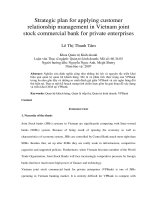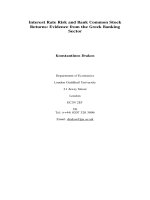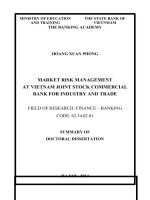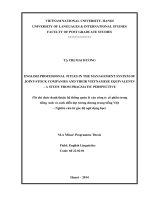Practice investment management pim3 ch05 common stock
Bạn đang xem bản rút gọn của tài liệu. Xem và tải ngay bản đầy đủ của tài liệu tại đây (818.33 KB, 31 trang )
CHAPTER FIVE
COMMON STOCK
Practical Investment Management
Robert A. Strong
Outline
Corporations, Shares, and Shareholder Rights
Corporations
Shares
Shareholder Rights
The Mystique of Dividends
Types of Dividends
Special Distributions
The Dividend Payment Procedure
Why Dividends Do Not Matter
South-Western / Thomson Learning © 2004
5-2
Outline
Stock Splits
Forward and Reverse Splits
Why Stock Splits Do Not Matter
Why Firms Split Their Stock
Stock Splits vs. Stock Dividends
The Financial Page Listing
The Basic Information
Footnotes and Symbols
South-Western / Thomson Learning © 2004
5-3
Outline
Categories of Stock
Blue Chip Stocks
Income Stocks
Cyclical Stocks
Defensive Stocks
Growth Stocks
Speculative Stocks
Penny Stocks
Category Overlap
A Note on Stock Symbols
South-Western / Thomson Learning © 2004
5-4
Corporations, Shares, and Shareholder Rights
People who own stock have an equity
interest in the organization.
If a business has shares of stock, it is
organized as a corporation rather than a
proprietorship or a partnership.
The shares of some corporations are closely
held, while others are publicly held.
The two types of stock are common stock
and preferred stock.
South-Western / Thomson Learning © 2004
5-5
Corporations, Shares, and Shareholder Rights
Shareholder Rights
the right to receive declared dividends on
a pro rata basis
the right to vote
- Some companies have more than one class
of stock.
the right to maintain ownership percentage
- The mechanics of the preemptive right are
accomplished by a rights offering.
South-Western / Thomson Learning © 2004
5-6
The Mystique of Dividends: Types of Dividends
cash dividends
- paid in cash
Some firms have an optional
dividend reinvestment plan.
South-Western / Thomson Learning © 2004
5-7
The Mystique of Dividends: Types of Dividends
Selected Dividend Reinvestment Plans
FIRM
Chase Manhattan Bank (CMB,NYSE)
Central Maine Power (CTP, NYSE)
Green Mountain Power (GMP, NYSE)
Hibernia Corp. (HIB, NYSE)
York Financial (YFED, NASDAQ)
South-Western / Thomson Learning © 2004
DISCOUNT
FROM
MARKET PRICE
5%
5%
5%
5%
10%
5-8
The Mystique of Dividends: Types of Dividends
Insert Figure 5-5 here.
South-Western / Thomson Learning © 2004
5-9
The Mystique of Dividends: Types of Dividends
stock dividends
- paid in additional shares of stock
property dividends
- the pro rata distribution of a
physical asset
South-Western / Thomson Learning © 2004
5 - 10
The Mystique of Dividends: Special Distributions
spin-offs - a parent firm divests itself of a
subsidiary, and all the shares in
the subsidiary are distributed
proportionally to the shareholders
in the parent
split-offs - a parent firm divests itself of a
subsidiary, and the shareholders
must make a choice between
keeping shares in the parent, or
exchanging them for shares
in the separated subsidiary
South-Western / Thomson Learning © 2004
5 - 11
The Mystique of Dividends: Special Distributions
An increasingly common type of
recapitalization is the issuance of shares
called tracking stock.
These shares track the performance of a
subsidiary, and in many respects, are just a
new class of shares.
South-Western / Thomson Learning © 2004
5 - 12
The Dividend Payment Procedure
The Chronology of Events
1. date of declaration
Ex-dividend date
(2 business days prior
to the date of record)
2. date of record
3. date of payment
South-Western / Thomson Learning © 2004
5 - 13
The Dividend Payment Procedure
A dividend paid in accordance with a
previously announced corporate policy is a
regular dividend.
Companies usually pay dividends quarterly.
A firm that wishes to make an extra
distribution of cash to the shareholders does
so through a special dividend, also called an
extra or extraordinary dividend.
South-Western / Thomson Learning © 2004
5 - 14
Why Dividends Do Not Matter
Paying dividends reduces the amount in a
firm’s checking account, and hence the
shares are worth less.
On the ex-dividend date,
share prices tend to fall by
about the amount of the
dividend.
South-Western / Thomson Learning © 2004
5 - 15
Stock Splits: Forward and Reverse Splits
A stock split is an accounting decision to
change the number of shares outstanding
without selling any more to the public.
With a forward split, also called a regular way
or direct split, shareholders end up with a
greater number of shares than before the
split.
With a reverse split, the number of existing
shares is reduced.
South-Western / Thomson Learning © 2004
5 - 16
Stock Splits: Why Stock Splits Do Not Matter
The value of a firm cannot be increased by
splitting, or combining, its shares.
South-Western / Thomson Learning © 2004
5 - 17
Stock Splits
The primary motivation for a stock split is
usually a desire to reduce the share price.
Large reverse splits often reduce the number
of shareholders.
The difference between a stock split and a
stock dividend is purely an accounting
phenomenon. With a stock split, the par
value of the stock changes by the split
factor. With a stock dividend, the par
value is not affected.
South-Western / Thomson Learning © 2004
5 - 18
The Financial Page Listing
52 Weeks
Hi
Lo
25.38 20.38
Yld
Stock
Sym Div
AtlanEngy ATE 1.54
Vol
Net
%
PE 100s
Hi
7.2
12
21.25 20.88 21.25
371
Lo Close Chg
Footnotes and Symbols
boldface type, underlined,
s, n, dd, g, x, ...
South-Western / Thomson Learning © 2004
,
,
,
5 - 19
+.13
The Financial Page Listing
new 52-week high
cc
dd
g
n
pf
s
wt
x
new 52-week low
PE ratio > 100
loss in the most recent four quarters
dividends and earnings in Canadian dollars
newly issued in the past 52 weeks
preferred stocks
stock split/stock dividend > 10% in past 52 weeks
warrant
ex-dividend
South-Western / Thomson Learning © 2004
5 - 20
Categories of Stock
A blue chip stock usually has a
long history of uninterrupted
dividends.
Income stocks are those that historically
have a higher-than-average payout ratio (the
proportion of net income after taxes paid as
a dividend).
A cyclical stock is one whose fortune is
directly tied to the state of the overall
national economy.
South-Western / Thomson Learning © 2004
5 - 21
Categories of Stock
Insert Table 5-2 here.
South-Western / Thomson Learning © 2004
5 - 22
Categories of Stock
Insert Table 5-3 here.
South-Western / Thomson Learning © 2004
5 - 23
Categories of Stock
Insert Table 5-4 here.
South-Western / Thomson Learning © 2004
5 - 24
Categories of Stock
A defensive stock is largely immune to
changes in the economy.
Growth stocks reinvest most of their
earnings rather than paying them out as
dividends and may be good candidates for
above-average returns.
A speculative stock has a high probability of
a loss and a small probability of a large
profit.
Penny stocks refer to unusually risky,
especially inexpensive shares.
South-Western / Thomson Learning © 2004
5 - 25









